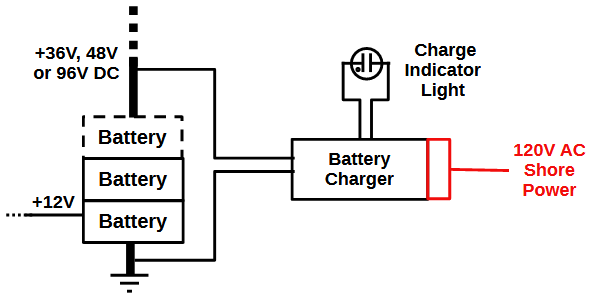Duffy Information Home Page
Battery Charging System
The information provided is for a 2002 Duffy 18' Classic. Many systems and components are common across models and years.
It is up to you to determine if this information applies to your boat or not.
Our boat has a 36V battery charger powered by 120V shore power. It charges (6) six volt batteries wired in series and is located under the aft seat.
Charging System
The battery charger is located under the rear seat. It uses shore power to charge the entire battery bank by connecting its outputs to the furthest positive and negative terminals in the bank. The "Charger On" light on the panel is powered by a signal from the battery charger.

Replacement Charger
If you are using the original Trojan T-105 batteries, here is Trojan's advice for a charger.
In general, the charger:
- must match the battery chemistry (e.g. lead acid), type (e.g. flooded), have an output voltage designed to charge your battery bank (e.g. 36VDC), and an input voltage matching your shore power (e.g. 120VAC).
- should be a "smart" charger with three charging phases in order to maximize battery life.
- requires an amperage rating sufficient for your battery bank and charging speed expectations.
Per Trojan: "charge rate should be between 10% and 13% of the battery’s 20-hour AH capacity. For example, a battery with a 20-hour capacity rating of 225 AH will use a charger rated between approximately 23 and 30 amps (for multiple battery charging use the AH rating of the entire bank). Chargers with lower ratings can be used but the charging time will be increased."
A single Trojan T105 has a 20-hour AH capacity of 225Ah. We have six batteries wired in series, so the total Ah capacity of our battery bank remains at 225Ah. If you have batteries wired in parallel, your amp hours will be higher.
Our original and replacement chargers were rated for a 20A output, which charges fast enough for us and likely has enough power for the charging cycles to properly maintain the batteries. A low amperage charger will not be able to perform each of the charging phases for proper battery maintenance.
Additional features you may want:
- A light or display on the charger that provides information about the charge mode and any errors.
- Connections for an output signal to power the "Charger On" light on the console.
- IP67 weather resistance.
- Ability to trickle charge if you leave your boat for long periods of time between uses. Most chargers run through one charge cycle, then stop. They sense battery voltage when initially plugged in, run through a charge cycle if required, then shut off until power to the charger is disconnected and reconnected.
Most replacement chargers will say they are for golf carts. This is fine as long as it meets the criteria above. The Duffy Classic propulsion system is based upon standard golf cart components.
Console "Charger On" light
The original indicator light is a 5/16" 125V AC neon panel light. These fail frequently. A good replacement is an 8mm LED that supports the signal voltage from your new charger.
Original Charger
Our original charger was a Zivan NG1 (user manual link).

Caution: The original wiring between the charger and the "Charger On" light carries 120V AC high voltage, but looks the same as low voltage wiring.
There is a light on the charger that shows the approximate state of charge as the charger sees it, which is useful for troubleshooting.
Duffy Information Home Page


